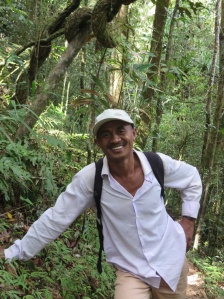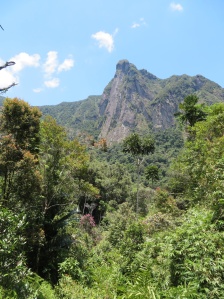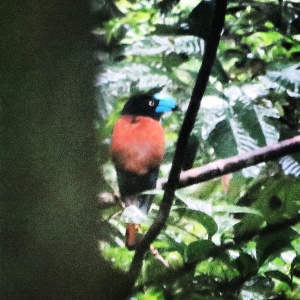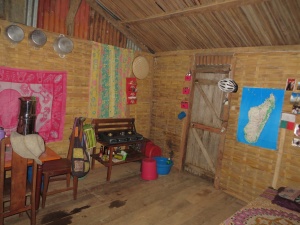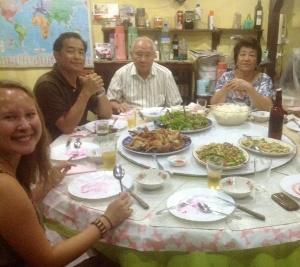 Meals have become my classroom for learning Malagasy and entertainment stage. There is always an eruption of laughter when I say things incorrectly or even when I have realized that I can “joke” in Malagasy. Once, when I was over for lunch, I tried to say “Izy efa mande mihinina miaraka VADYNY.” (He already left to eat with his wife.) I accidentally said VODYNY, which ended up meaning that he already left to go eat with his BUTT. I was embarrassed because I was a guest. Everyone laughed. Forever. Kristen told me that they still talked about it for the following week. I’ve previously talked about the delicious and plentiful food at dinner with Mimi. She ENJOYS food and having meals with others. I’ve tried many different dishes here ranging from cow tongue, wild pig, coconut fish, and many many Chinese specialties. Most of the time, I get voted to split the last piece of everything with Mimi’s nephew. At times, there are two different desserts served, including fresh fruit. One night, after having dessert #2, I said “Tiako be satria mammy anó,” Literally meaning I LOVE YOU BECAUSE YOU’RE SWEET. I wanted to say that he loves dessert because it’s sweet. Everyone burst into laughter. When I’m not saying ridiculous things, we laugh because papa won’t stop feeding the cats underneath the table which has been highly disapproved by Mimi.
Meals have become my classroom for learning Malagasy and entertainment stage. There is always an eruption of laughter when I say things incorrectly or even when I have realized that I can “joke” in Malagasy. Once, when I was over for lunch, I tried to say “Izy efa mande mihinina miaraka VADYNY.” (He already left to eat with his wife.) I accidentally said VODYNY, which ended up meaning that he already left to go eat with his BUTT. I was embarrassed because I was a guest. Everyone laughed. Forever. Kristen told me that they still talked about it for the following week. I’ve previously talked about the delicious and plentiful food at dinner with Mimi. She ENJOYS food and having meals with others. I’ve tried many different dishes here ranging from cow tongue, wild pig, coconut fish, and many many Chinese specialties. Most of the time, I get voted to split the last piece of everything with Mimi’s nephew. At times, there are two different desserts served, including fresh fruit. One night, after having dessert #2, I said “Tiako be satria mammy anó,” Literally meaning I LOVE YOU BECAUSE YOU’RE SWEET. I wanted to say that he loves dessert because it’s sweet. Everyone burst into laughter. When I’m not saying ridiculous things, we laugh because papa won’t stop feeding the cats underneath the table which has been highly disapproved by Mimi. 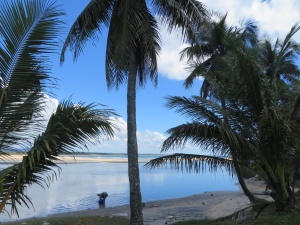 In this short time, I have felt warmly welcomed. Little things have created a sense of home here for me. I tutor ladies on Sundas in the afternoon. The Sunday after my birthday, I was confused and somewhat annoyed that they wanted to end early. I walked downstairs and was surprised with a birthday cake, wontons, and a giant bottle filled with coconut water! The cake was decorated with ” “Happy Birthday,” in English. It was a special surprise. I teared up as they handed me Madagascar souvenirs to bring back home. This year, I had two birthday cakes. On my birthday, Mimi baked a beautiful cake for me and I blew out 26 candles. In the mornings, I ride past my “fruit lady” as she waves and says she’s got papaya, mangos, or bananas. I usually buy fruit from the same ladies at the market. It is nice to ride by and see them each day. The first day I rode in a taxi brousse to Andapa, I sat on the window seat admiring the views of coconut palms and of the forest. I sat with one legover another, only having half my butt on the seat at one time. Taxi brouisses are usually 20 passenger vans filled with 40ish people all riding together, with no set agenda or the slightest worry about time. Everyone happily rides along, chatting together like one big family. It is not uncommon for babies to be held by strangers or youngsters to be sitting on your lap. Periodically, we were stopped by the gandarme on the roads. The man smiled and began speaking French to me. I answered, “Azafady, fo zaho tsy mahay teny Francais.” ( Sorry, but I don’t speak French.) His face lit up in confusion and asked if I was a tourist. I said, “I am not a tourist, I am a Peace Corps Volunteer.” That was the first time I realized how awesome it was to say that I wasn’t a tourist in this place. He practiced his little bit of English with me and waved veloma. Getting together with other Peace Corps volunteers who live in nearby areas is another way of creating the feeling of having an extended family here in Madagascar. The weekend of Kim’s birthday was during “Fety Maty” (similar to Day of the Dead). We decided to bring our bikes along in the taxi brouisse. That time, the brouisse broke down at least six times. The trip from Sambava to Andapa which normally would take about 2-3 hours took almost 6. We frequently were asked to get off the brousse and walk. The first three times it happened, I was amused and enjoyed the walk. We were only 7k away from our destination, when we started getting annoyed with the many times we broke down. We asked the driver if we could get our bikes and ride the rest of the way. He laughed and others did too as if we had requested the most ridiculous thing ever. Kristen, Ari and I traveled together. Ari has already been in Madagascar for over a year so her Malgasy is more advanced than ours. We put her in charge of convincing the driver to let us have our bikes. It finally worked when we were 4k away from town. I laughed hysterically at the comments from the driver as he gave us our bikes. Others in the crowd laughed too because they knew that we understood. Riding to Matsobe ( a village outside of Andapa) was so much fun!
In this short time, I have felt warmly welcomed. Little things have created a sense of home here for me. I tutor ladies on Sundas in the afternoon. The Sunday after my birthday, I was confused and somewhat annoyed that they wanted to end early. I walked downstairs and was surprised with a birthday cake, wontons, and a giant bottle filled with coconut water! The cake was decorated with ” “Happy Birthday,” in English. It was a special surprise. I teared up as they handed me Madagascar souvenirs to bring back home. This year, I had two birthday cakes. On my birthday, Mimi baked a beautiful cake for me and I blew out 26 candles. In the mornings, I ride past my “fruit lady” as she waves and says she’s got papaya, mangos, or bananas. I usually buy fruit from the same ladies at the market. It is nice to ride by and see them each day. The first day I rode in a taxi brousse to Andapa, I sat on the window seat admiring the views of coconut palms and of the forest. I sat with one legover another, only having half my butt on the seat at one time. Taxi brouisses are usually 20 passenger vans filled with 40ish people all riding together, with no set agenda or the slightest worry about time. Everyone happily rides along, chatting together like one big family. It is not uncommon for babies to be held by strangers or youngsters to be sitting on your lap. Periodically, we were stopped by the gandarme on the roads. The man smiled and began speaking French to me. I answered, “Azafady, fo zaho tsy mahay teny Francais.” ( Sorry, but I don’t speak French.) His face lit up in confusion and asked if I was a tourist. I said, “I am not a tourist, I am a Peace Corps Volunteer.” That was the first time I realized how awesome it was to say that I wasn’t a tourist in this place. He practiced his little bit of English with me and waved veloma. Getting together with other Peace Corps volunteers who live in nearby areas is another way of creating the feeling of having an extended family here in Madagascar. The weekend of Kim’s birthday was during “Fety Maty” (similar to Day of the Dead). We decided to bring our bikes along in the taxi brouisse. That time, the brouisse broke down at least six times. The trip from Sambava to Andapa which normally would take about 2-3 hours took almost 6. We frequently were asked to get off the brousse and walk. The first three times it happened, I was amused and enjoyed the walk. We were only 7k away from our destination, when we started getting annoyed with the many times we broke down. We asked the driver if we could get our bikes and ride the rest of the way. He laughed and others did too as if we had requested the most ridiculous thing ever. Kristen, Ari and I traveled together. Ari has already been in Madagascar for over a year so her Malgasy is more advanced than ours. We put her in charge of convincing the driver to let us have our bikes. It finally worked when we were 4k away from town. I laughed hysterically at the comments from the driver as he gave us our bikes. Others in the crowd laughed too because they knew that we understood. Riding to Matsobe ( a village outside of Andapa) was so much fun! 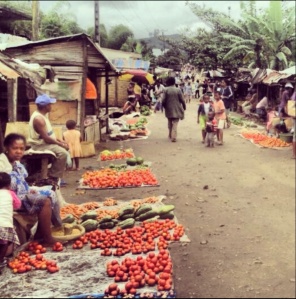
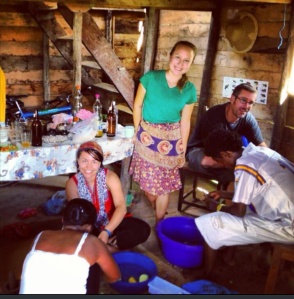 We had shopped at the market that morning in Andapa and shoved all the food in backpacks to bike over. We even managed to bring a cake in a bag! For the next few hours, we enjoyed preparing many dishes and were able to eat just in time before it got dark. There is no electricity at Kim’s site. Candles were lit at dark and we continued our fety (party.) Many of her neighbors joined us throughout the day. That night, we decided to visit the next village who was throwing an outdoor dance party. We stopped on the way to eat brochettes and followed the sounds of music as we walked inside basically and outdoor dance club. It was so fun to dance underneath a blanket of stars! People seemed happy to see us there and enjoyed dancing with us. At one point, I had about twenty kids surround me. It was fun to be dancing on Haloween night.
We had shopped at the market that morning in Andapa and shoved all the food in backpacks to bike over. We even managed to bring a cake in a bag! For the next few hours, we enjoyed preparing many dishes and were able to eat just in time before it got dark. There is no electricity at Kim’s site. Candles were lit at dark and we continued our fety (party.) Many of her neighbors joined us throughout the day. That night, we decided to visit the next village who was throwing an outdoor dance party. We stopped on the way to eat brochettes and followed the sounds of music as we walked inside basically and outdoor dance club. It was so fun to dance underneath a blanket of stars! People seemed happy to see us there and enjoyed dancing with us. At one point, I had about twenty kids surround me. It was fun to be dancing on Haloween night. 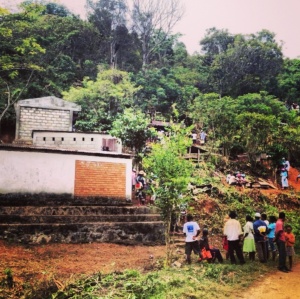 For “Fety Maty,” people visit their ancestor’s tombs and do a deep cleaning of the whole area. We walked over to the tomb area with one of Ari’s adopted Malagasy mother the following morning. All tombs were on a hill just outside of town. Many people were headed there. Some carried new coffins, food, and others drank tokagasy (Malagasy moonshine) like it was water. An abundance of street food and tokagasy was being sold everywhere. Unlike in the U.S., some of the tombs looked like housing structures. I learned that families usually put all members in the same tomb. Fety Maty is another way to demonstrate how important honor and respect to ancestors is in Malagasy culture.
For “Fety Maty,” people visit their ancestor’s tombs and do a deep cleaning of the whole area. We walked over to the tomb area with one of Ari’s adopted Malagasy mother the following morning. All tombs were on a hill just outside of town. Many people were headed there. Some carried new coffins, food, and others drank tokagasy (Malagasy moonshine) like it was water. An abundance of street food and tokagasy was being sold everywhere. Unlike in the U.S., some of the tombs looked like housing structures. I learned that families usually put all members in the same tomb. Fety Maty is another way to demonstrate how important honor and respect to ancestors is in Malagasy culture.
“In this heavy rain, watch your eyes for leaches,”
was literally what our guide said as we hiked out of Marojejy National Park. I was invited to visit the park for the first time with people from the Duke Lemur Center. It was incredible seeing so much primary forest, endemic wildlife species and spending time with other Americans. We got to watch silky sifakas (which are endemic to the SAVA region) and other lemurs swing among the trees. Our first night at camp one, we arrived just in time for dinner. Other groups stayed the night at camp one as well. I joined a Japanese photographer and his guide on a night walk to take pictures of insects. It was like seeing a live version of magazine pictures. We saw frogs, spiders that throw their nets to catch prey, nocturnal lemurs, and crickets that looked like they were angles in the dark. The view from camp 2 was phenomenal. 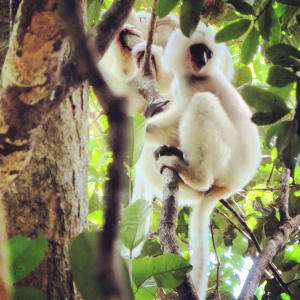 We stayed two nights there. I really wanted to go to the summit, and tried to convince one of our guides to take me, (it would have been about a 10 hour hike through very steep terrain.) I was unsuccessful in my mission but really enjoyed our search for lemurs the next day. One of the women in our group was on a search to find Madagascar’s Helmet Vanga, ( a bird only found on the northeast.) A photo of this bird was worth a very expensive bottle of wine to her neighbor. On our hike out of the park, It poured and poured. It had not rained the past few days and I was soaked. I had decided not to bring my rain jacket because I thought that being “a little wet” was better than being HOT in my rain jacket. I was drenched and regretted my stupid decision of not bringing my rain jacket. I had never seen rain that heavy in Madagascar and thought that it was a mere exaggeration for people to say that a rain jacket was necessary. I learned the hard way. It rained like it does in Southern Arizona during monsoon. I felt something slimy on my neck and began screaming and hopping around frantically. Brit helped pull a small leech off my neck. I was the first to get sucked by a leech. From then on, we frequently stopped to check each other for leeches, (face, neck, and eyes.) Jackson, one of our guides suddenly stopped on the trail and waited.
We stayed two nights there. I really wanted to go to the summit, and tried to convince one of our guides to take me, (it would have been about a 10 hour hike through very steep terrain.) I was unsuccessful in my mission but really enjoyed our search for lemurs the next day. One of the women in our group was on a search to find Madagascar’s Helmet Vanga, ( a bird only found on the northeast.) A photo of this bird was worth a very expensive bottle of wine to her neighbor. On our hike out of the park, It poured and poured. It had not rained the past few days and I was soaked. I had decided not to bring my rain jacket because I thought that being “a little wet” was better than being HOT in my rain jacket. I was drenched and regretted my stupid decision of not bringing my rain jacket. I had never seen rain that heavy in Madagascar and thought that it was a mere exaggeration for people to say that a rain jacket was necessary. I learned the hard way. It rained like it does in Southern Arizona during monsoon. I felt something slimy on my neck and began screaming and hopping around frantically. Brit helped pull a small leech off my neck. I was the first to get sucked by a leech. From then on, we frequently stopped to check each other for leeches, (face, neck, and eyes.) Jackson, one of our guides suddenly stopped on the trail and waited.
There he stood in the pouring rain, the famous Helmet Vanga. We admired it for a few minutes as the rest of the group caught up. I pulled my camera out from my pack and managed to get a picture! For me, a photo was worth a nice care package from America! My clothes dried by the time we got back to the village of Mandena. As we waited for our car, I was tempted to take my boots off because my socks were wet inside. One of the guys mentioned that we might have blood in our boots from leeches feasting. I could’t bare the thought in my head and decided to delay the mystery until I got home. Thankfully, I had no leeches in my boots! I had tucked my pants into my boots to further prevent leeches from getting me.
I stood for about ten long minutes starring and thinking to myself that this was it. I was on my own. Nothing major has been “tough” or a “struggle” up until now. There was no one here to help me kill the cockroach. I had not seen one in this country up until now. And it was in my house! When I finally worked up the courage to make a decision to act, I went to grab the heaviest shoe I found and when I returned, it was gone. I silently hoped that it was gone forever. My home here is made of traditional regional materials, the Travelor’s Palm Tree, Bamboo and wood. The walls in my bedroom have been decked out Malagasy style. I call it the fun room. I have electricity and water is fetched from a well or a faucet (when it is running) nearby. Normally, I fill two buckets of water daily as a routine, one for showering and one to keep my water filter full. I have a few neighbors that live very near. I sometimes have lunch with Joxe, his wife Tina, and baby Nigel next door. I enjoy visiting Nigel and helping Tina practice English. There is an enormous lychee tree right outside my house. Outside my door is a papaya tree and on my walk to get water, I have to be on the lookout for mangoes falling on my head. I am grateful for the reality of living in a tropical place. I was in awe on a run one morning as I noticed pineapples growing wild! It was like being in the Pacific Northwest, where blackberries grow wild but instead it was pineapples and jackfruit. Peace Corps trained us all really well in recognizing parasites, flees, etc. I was clipping my toenails one morning when I noticed something different on my toe. It had to be it! A parasy (sand flea.) I lifted the skin and let’s just say that what oozed out was an image that I couldn’t get out of my head for two days.
